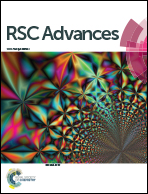Colorimetric chemosensor for multiple targets, Cu2+, CN− and S2−†
Abstract
A simple and easily synthesized colorimetric chemosensor 1, (E)-2-(((2-((2,4-dinitrophenyl)amino)phenyl)imino)methyl)phenol, was designed and synthesized for the detection of Cu2+, CN− and S2−. Receptor 1 showed a highly selective colorimetric response to copper(II) ions by changing its color from pale yellow to orange immediately without any interference from other metal ions. Also, the sensitivity of UV-vis based assay (8.77 μM) for Cu2+ is below the World Health Organization (WHO) guidelines for drinking water (31.5 μM). In addition, chemosensor 1 could be used to quantify Cu2+ in water samples and the sensing mechanism of the 1–Cu2+ complex was explained by theoretical calculations. The 1–Cu2+ complex could be reversible simply through treatment with an appropriate reagent such as EDTA. Moreover, with the “naked eye” 1 could sense cyanide and sulfide by color changes from pale yellow to pale pink and deep pink, respectively, in aqueous solution. Furthermore, sensor 1 can detect both CN− (0.28 μM) and S2− (10.7 μM) below the given guidelines (WHO: 1.9 μM for CN− and Environmental Protection Agency: 7.8 mM for S2−).


 Please wait while we load your content...
Please wait while we load your content...